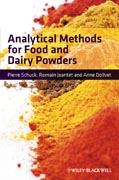
A unique overview of the new analysis techniques used in the safety and quality analysis of modern food and dairy powders – important ingredients in food processing. Food and dairy powders are created by dehydrating perishable produce, such as milk, eggs, fruit and meat, in order to extend their shelf life andstabilise them for storage or transport. These powders are in high demand foruse as ingredients and as food products in their own right, and are of great economic importance to the food and dairy industry worldwide. Today, the ability to control food and dairy powder quality is a source of key competitive advantage. By varying the dehydration process design, and by controlling the technological and thermodynamic parameters during dehydration, it is possible for manufacturers to engineer the biochemical, microbiological and physical characteristics of the food powder to meet their specific product requirements. Thisbook provides an overview of the existing, adapted or new techniques used to analyse safety and quality in modern food and dairy powders. Based on originalresearch by the authors, the book uses 25 commercial dairy and non-dairy powders to illustrate a range of biochemical and physical methods used to evaluateand characterise powdered food products. Written from a practical perspective, each chapter focuses on a particular analytical technique, outlining the purpose, definition and principle of that method. The authors guide the reader through all of the instruments needed, the safety measures required, and the correct procedures to follow to ensure successful analysis. Instructions on accurate measurement and expression of results are included, and each chapter is richly illustrated with original data and worked examples. Analytical Methods for Food and Dairy Powders is a unique step-by-step handbook, which will be required reading for anyone involved in the development and manufacture of powdered food products. Food and dairy scientists based in industry will find it essential for new product development and improved quality control, while researchers in the laboratory will especially value the new techniques it comprises.
- ISBN: 978-0-470-65598-6
- Editorial: John Wiley & Sons
- Encuadernacion: Cartoné
- Páginas: 248
- Fecha Publicación: 06/04/2012
- Nº Volúmenes: 1
- Idioma: Inglés
